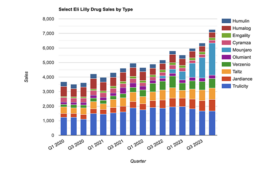 Bone marrow transplants are currently a $1.3 billion market, representing the fastest-growing hospital procedure in the United States. They are the only potential cure for many blood cancers, such as acute myeloid leukemia (AML), in older patients. The procedure is technically called hematopoietic stem cell transplantation (HSCT) and can be either a bone marrow transplant (BMT) or transplant of blood stem cells isolated from peripheral blood (PBSC). In either case, it involves transplanting cells capable of restoring normal bone marrow function into a patient.
Bone marrow transplants are currently a $1.3 billion market, representing the fastest-growing hospital procedure in the United States. They are the only potential cure for many blood cancers, such as acute myeloid leukemia (AML), in older patients. The procedure is technically called hematopoietic stem cell transplantation (HSCT) and can be either a bone marrow transplant (BMT) or transplant of blood stem cells isolated from peripheral blood (PBSC). In either case, it involves transplanting cells capable of restoring normal bone marrow function into a patient.
An increasing number of patients in need of HSCT are over the age of 55, but many in this group are ruled ineligible. This is because the high-doses of chemotherapy and radiation used to prepare patients for HSCT— standard therapy for younger patients— are often deemed too harsh even for healthy-looking older people. Indeed, in certain indications, more than one-third of patients over 50 treated with standard transplant regimens die as a direct consequence of treatment, while almost half still have the leukemia recur.
Since more than half of AML patients are over 65 years old, new tactics to prepare these patients for HSCT are needed. For example, what if a patient’s existing bone marrow could be prepared prior to the transplant, through a process called myeloconditioning, in a way that eliminated the need for high-dose chemotherapy? This promising approach is being pursued by Actinium Pharmaceuticals Inc., a New York City-based biotech company, under the guidance of its Chief Medical Officer, Dragan Cicic, M.D.
The company’s approach to cancer treatment is based on combining the cancer-targeting precision of monoclonal antibodies (mAb) with the power of radioisotopes. To this end, it is developing two compounds currently in clinical trials, Iomab-B and Actimab-B.
Actinium’s lead compound, Iomab-B, has been successfully harnessed as a myeloconditioning agent in Phase 1/2 trials involving more than 250 patients, including cases of incurable blood cancers, such as AML, resistant to all available therapies. It has demonstrated the ability to prepare such patients for bone marrow transplants when no other treatment was indicated.
Iomab-B is a radioimmunoconjugate consisting of BC8, a novel murine monoclonal antibody, and iodine 131 radioisotope. BC8 was developed at the Fred Hutchinson Cancer Research Center to target CD45, a pan-leukocytic antigen widely expressed on white blood cells but not on other tissues. Presence of this antigen makes BC8 potentially useful in targeting white blood cells in preparation for HSCT in a number of blood cancer indications, including AML, chronic myeloid leukemia, acute lymphoblastic leukemia, chronic lymphocytic leukemia, Hodgkin disease, Non-Hodgkin lymphomas and multiple myeloma. When labeled with radioactive isotopes, BC8 carries radioactivity directly to the site of cancerous growth and bone marrow while avoiding effects of radiation on most healthy tissues.
With any cancer treatment, success is usually increased when treatment initiates soon after diagnosis. This is especially true when projected survival is only a few months. Waiting for half that time to transplant the patient inevitably has a serious impact. Very significantly, treatment with Iomab-B prepares a patient for bone marrow transplant in only 10 days, compared to approximately six weeks required with traditional care— a potentially vital difference in the face of a fast-evolving cancer.
The advantages of this approach are clear: The majority of older AML patients are ineligible for bone marrow transplant, the only potentially curative treatment option for this group. However, with Iomab-B, most patients are eligible, and clinical studies indicate their survival rates are significantly higher. Iomab-B enables bone marrow transplant in older patients who have survived chemo but whose AML either was not cured or returned.
On the strength of results showing its potential in Phase 1/2 trials, the company is poised to begin a Phase 3 trial during 2014. The primary endpoint will be the rate of durable complete remission among the treated patients. A series of physician-led trials involving Iomab-B is also ongoing.
The promise of radioimmunotherapy goes far beyond bone marrow transplants. Actinium also has a technology co-developed with Memorial Sloan Kettering Cancer Center that relies on the power of alpha emitters, a special class of radioisotopes, to kill hidden cancer cells with doses of radiation so low that they are undetectable in the body. In many cancers, a small group of cells remains secluded and out of reach of current therapies and that’s why some cancers return after being put into remission.
But for now, Actinium’s radioimmunotherapy compound closest to the market is Iomab-B. If a new trial of this compound confirms previous results, it could result in a paradigm-changing approach to treatment for those over age 55 in need of bone marrow transplants, offering a fresh and effective treatment for a patient population sorely in need of new options.
Kaushik J. Dave, Ph.D., is president and CEO of Actinium Pharmaceuticals, Inc., a biopharmaceutical company developing innovative targeted payload immunotherapeutics for the treatment of advanced cancers.
Filed Under: Drug Discovery




